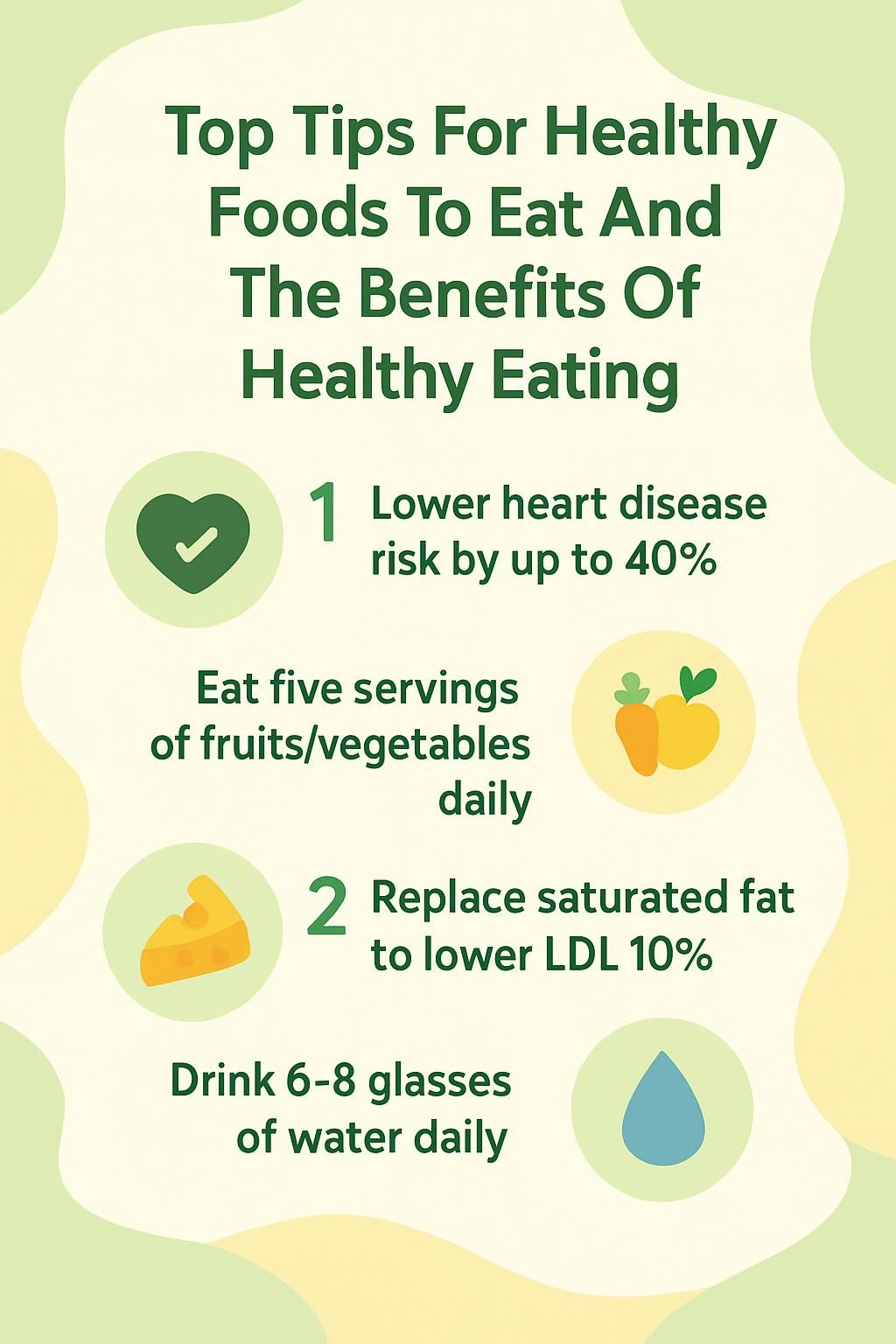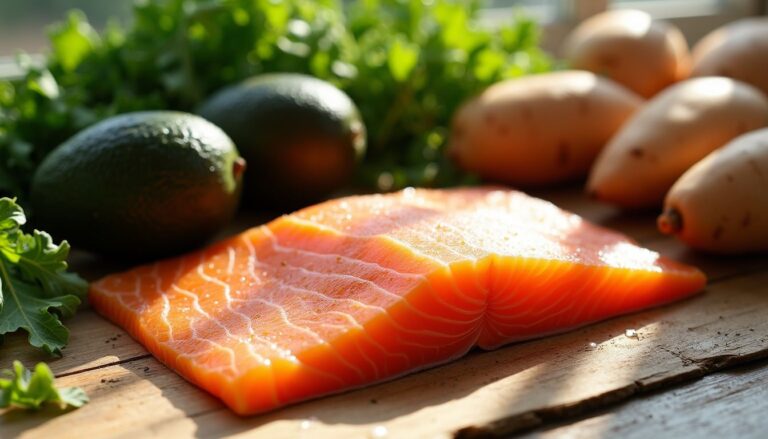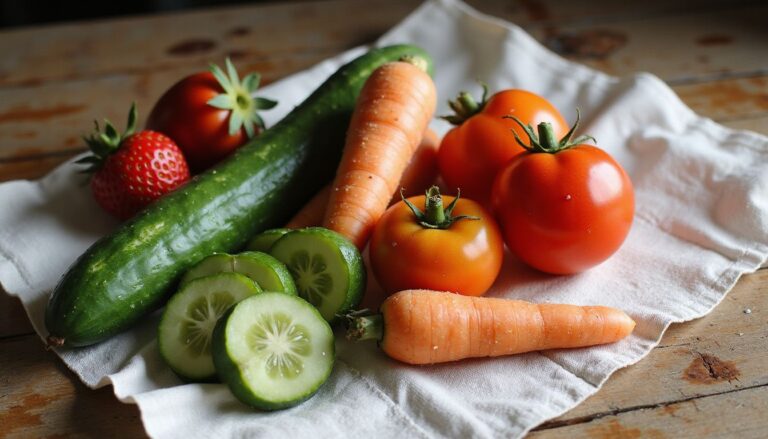Top Tips For Healthy Foods To Eat And The Benefits Of Healthy Eating
Our Nutrition Assistant AI Suite will transform your body. You will lose fat, get toned, and build muscle. Gain confidence and optimal health.
Many people want to eat better but do not know which healthy foods to choose or how to fit them into a busy day. That confusion can make healthy eating feel harder than it needs to be. I keep it simple by focusing on a few core habits that support a balanced diet and a healthy weight.
Research links more fruits, vegetables, lean meats, and whole grains with lower risk of heart disease and type 2 diabetes. In this article, I share clear tips you can use today and explain how nutritious foods make daily meals stronger. If you want a straightforward way to improve your plate, you are in the right place.
Key Takeaways
- Eating more fruits, vegetables, lean proteins, and whole grains can cut the risk of heart disease and type 2 diabetes by up to 40% (Harvard School of Public Health, Healthy Eating Index).
- Fresh, minimally processed foods high in fiber and unsaturated fat help with weight control and lower the risk of obesity, high blood pressure, and cardiovascular disease.
- The Eatwell Guide suggests at least five servings of fruits or vegetables each day to support nutrient needs and reduce chronic illness risk.
- Drinking 6 to 8 glasses of water daily supports digestion, energy, focus, and weight control, as noted in the Eatwell Guide.
- Replacing saturated fat with healthy oils such as olive oil can lower LDL cholesterol by about 10%, based on a 2020 review in Circulation.

Understanding Healthy Foods

Healthy foods give my body the nutrients it needs to work well. My eating plan shapes how I feel, how I perform, and how I lower my risk of heart disease.
Definition of healthy foods
Foods labeled as healthy are whole, minimally processed, and nutrient dense. They supply macronutrients, which are protein, carbohydrates with fiber, and healthy fat. For example, broccoli offers vitamin C and fiber, and brown rice provides dietary fiber and B vitamins.
Whole foods such as leafy greens, fruit, beans, nuts, lean poultry, and fish deliver vitamins and minerals without added sugar or excess sodium. Guidance from the Healthy Eating Plate at Harvard highlights foods that are low in saturated fat and free of artificial additives as strong choices for a balanced diet.
Foods rich in unsaturated fat, such as olive oil and walnuts, support heart health. When I swapped white bread sandwiches for quinoa and spinach salads at lunch, my energy stayed steady through the afternoon.
Nutrient dense choices reduce the risk of obesity and cardiovascular disease compared with highly processed options that are high in calories but light on nutrients.
Key components: fruits, vegetables, whole grains, lean proteins, and healthy fats
A closer look shows five groups that build a nutritious diet. Each one plays a role in eating a balanced diet and supports long term health.
- Fruits such as apples, avocados, and bananas supply fiber, vitamin C, and potassium. Apples help steady blood sugar, and avocados support heart health with healthy fat.
- Vegetables like broccoli, kale, and carrots are rich in fiber and antioxidants. Eating leafy greens boosts vitamin intake and may lower the risk of cancer or stroke, according to the American Heart Association.
- Whole grains including brown rice, oats, and quinoa provide magnesium and protein. Oats contain beta glucans, a fiber that helps control cholesterol.
- Lean proteins from eggs, chicken breast, or lean beef support muscle. I also use cottage cheese and legumes, since they add protein with less fat and fit most meal plans.
- Healthy fats from extra virgin olive oil and oily fish supply omega 3 fatty acids. Using plant oils or adding nuts like almonds can support healthy blood pressure and improve cholesterol.
Top Tips for Choosing Healthy Foods
I make choices that protect my health and fuel my day. Small shifts in daily meals add up to stronger eating patterns over time.
Prioritize fresh, whole foods
Fresh foods like fruit, vegetables, nuts, seeds, and yogurt form the core of a healthy diet. A 2021 analysis of thousands of foods ranked minimally processed choices as the most healthful.
Fresh produce is high in nutrients and antioxidants, and it tends to be low in saturated fat and sodium. Sweet potatoes are a good source of fiber plus vitamins A and C. Nuts offer heart friendly fats that support the circulatory system.
Many whole foods need little prep, so they are easy to pack or add to salads. I keep cucumbers, tomatoes, barley soup, yogurt, and hummus ready for quick meals and snacks. Whole grains like brown rice digest more slowly than refined grains, so they provide steady energy without a blood sugar spike.
Eating a mix of foods each week helps me cover all the key nutrients my body needs.
Learning to read food labels helps me avoid hidden trans fat and high sodium in packaged items.
Read food labels
After I choose fresh foods, I compare labels to make smart choices. Nutrition panels list serving size, calories, and key nutrients such as fiber and sodium.
For example, a whole grain bread label often shows more fiber and less added sugar than white bread. The Dietary Guidelines for Americans advise picking foods low in saturated fat and sodium while watching for added sugars.
Ingredients lists also flag allergens like nuts, gluten, or dairy products, which is critical for people with sensitivities. A quick check helps me spot healthy fats such as olive oil or peanuts instead of butter or mayonnaise that are high in saturated fat. These steps support a heart healthy diet and fit well with patterns like the Mediterranean diet.
Opt for seasonal and local produce
Reading labels gives me facts. I pair that habit with buying seasonal and local produce. Seasonal fruits and vegetables are fresher, cost less, and keep more nutrients because they spend less time in transit.
The Eatwell Guide recommends building meals around a variety of these foods to cover major food groups. Local choices also reduce the environmental impact from long distance shipping.
Picking apples at a nearby orchard or grabbing leafy greens at a farmers market supports my community and adds variety that benefits gut microbiota, the helpful bacteria in the digestive tract. In peak season, I find nutrient rich berries at lower prices. Cooking with fresh garlic or skin on potatoes grown nearby also improves flavor while aligning with healthy eating guidance.
Seasonal options work for plant based diets or for people limiting red meat. Many months offer local nuts, vegetables, low fat dairy like milk, grains such as whole wheat pasta, and healthy snacks.
The United States Department of Agriculture also encourages diverse produce to reduce chronic disease risk and to help maintain a healthy body weight.
Limit processed options
Along with seasonal picks, I limit processed foods in my daily diet. Highly processed foods often contain more saturated fat, sodium, and added sugar.
Eating too much of those ingredients raises the risk of obesity, high blood pressure, and cardiovascular disease. Packaged snacks and desserts are usually calorie dense yet low in important nutrients like fiber and potassium.
I focus on whole grains, fresh fruit, and lean meats as my main source of protein. Public health guidance encourages eating less salt and sugar and avoiding foods high in unhealthy fats. Cutting back on sugary cereals and store bought juice helped me manage my weight and lower my heart risk.
If I want crunch at lunch, I choose nuts instead of chips. Nuts deliver healthy fats rich in omega 3 fatty acids and add satisfying texture to salads.
Benefits of Eating Fruits and Vegetables
A colorful mix of produce is like a daily multivitamin you can chew.
Rich in nutrients and antioxidants
Apples provide fiber and vitamin C, which help me feel full and support immunity. Avocados offer healthy fat, fiber, potassium, and vitamin C that support heart health.
Blueberries stand out for their antioxidants, which protect cells from damage. Strawberries supply vitamin C, fiber, and manganese, and they are low in calories.
Carrots deliver beta carotene for vision, vitamin K for immunity, and fiber for digestion. Kale also fits many meals and brings vitamins C and K plus a range of plant nutrients.
Eating a variety each day supports heart health and ensures I get many different nutrients.
Reduces risk of diseases
At least five portions of fruits and vegetables each day can lower my risk of heart disease, stroke, and some cancers. Higher Healthy Eating Index scores are linked with up to a 40% lower chance of cardiovascular disease.
Garlic contains allicin, a plant compound with antioxidant effects that may help blood pressure and reduce cancer risk. Diets centered on plant foods also connect with less obesity and fewer chronic conditions.
Produce rich menus tend to be lower in saturated fat and higher in healthy fats and fiber. Nuts add potassium, which helps regulate blood pressure, and they support weight loss efforts by increasing fullness.
Importance of variety
Variety matters. Different colors signal different nutrients. I aim for a rainbow to get many phytonutrients, which are plant compounds that support health.
Leafy greens are good sources of potassium. Berries provide antioxidants that may help lower the risk of heart attack, also called myocardial infarction. A 2021 food scoring system ranked foods by nutrient density, and rotating produce choices supports better coverage of those nutrients.
Seasonal and local produce helps me keep variety all year. I rotate root vegetables, citrus fruits, whole grains, nuts like almonds and walnuts, and dairy in moderation to balance calories without raising blood pressure.
Incorporating Whole Grains
Whole grains act like slow burning fuel for steady energy.
Difference between whole grains and refined grains
Whole grains keep all three parts, the bran, germ, and endosperm. That means foods like whole grain bread or brown rice deliver more fiber, vitamins, and minerals than refined grains. I check labels to make sure I am getting true whole grains.
Refined grains lose the bran and germ during processing, so the final product has fewer nutrients. A half cup of cooked whole grains is about 75 to 100 grams.
The Eatwell Guide and Healthy Eating Plate both recommend eating more whole grain foods for better health outcomes. Whole grain breads and cereals usually have more fiber and less sugar than white or refined options, which supports heart health and healthy blood pressure.
Health benefits
Whole grains help with weight management because fiber helps me feel full and eat less. Oats contain beta glucans, a type of fiber that lowers cholesterol and supports gut health.
Brown rice has more fiber, vitamin B1, and magnesium than white rice. This swap is linked with a lower risk of type 2 diabetes.
Quinoa provides plant protein and works for people who need gluten free options. Studies connect higher whole grain intake with lower risk of heart disease, some cancers, obesity, and metabolic syndrome.
Adding nuts to grain bowls supplies healthy fat without raising blood pressure. These small changes deliver steady energy all day.
Tips for adding whole grains to meals
Whole grains offer more fiber, vitamins, and minerals than refined grains. Swapping refined choices for whole grains boosts the nutritional value of the food you eat and supports blood pressure control.
- Replace white rice with brown rice or quinoa in stir fries and salads for more fiber and potassium.
- Choose whole grain bread for sandwiches or toast, and compare labels for higher fiber.
- Add oats to breakfast as oatmeal or blend oats into smoothies for extra nutrients.
- Use whole grain pasta or barley in soups, stews, or casseroles to support heart health.
- Try homemade bread with sprouted whole grains and legumes for a nutrient dense option.
- Shift gradually from refined to whole grains so your taste buds can adjust.
- Pick popcorn for a snack, since it is a whole grain. Skip excess salt that can raise blood pressure.
- Mix cooked bulgur or farro into salads to increase how many healthy foods you eat each week.
- Swap refined flour crackers for ones with 100 percent whole wheat or other whole grains listed first.
The Importance of Lean Proteins
I lean on protein to maintain muscle and steady my energy through long days.
Sources of lean proteins
Lean beef provides plenty of protein and easy to absorb iron for energy and muscle function. Chicken breast is low in fat and calories and is a popular, flexible source of protein.
Eggs contain all essential amino acids, so they are a complete protein. They work well at breakfast or lunch.
Lentils and kidney beans offer plant protein plus fiber and other nutrients, and they are easy to add to salads or soups. Shellfish such as clams, oysters, and shrimp provide high quality protein with little fat.
Low fat dairy products like reduced fat cheese and yogurt help meet daily protein needs with less saturated fat. I often drink milk after workouts to rehydrate and add protein at the same time.
Benefits for muscle maintenance and overall health
Protein helps repair and maintain muscles, especially if I am active or losing weight. Higher protein diets support better muscle retention during weight loss, as shown in recent studies.
Chicken and fish supply high quality protein while staying low in saturated fat. Shrimp delivers protein and zinc with few calories, which supports immune function and muscle health.
Meals rich in lean protein improve satiety and metabolic function and support bone health. People who eat more lean proteins show lower risk of chronic diseases such as cardiovascular disease.
Tips for incorporating proteins into meals
I use simple steps to add protein to every meal. This approach helps me stay full and maintain muscle.
- I add eggs at breakfast for a fast, high quality protein boost.
- I use chicken or turkey in salads, stir fries, or whole grain wraps for lunch or dinner.
- I add beans and lentils to soups, stews, and casseroles for plant protein and fiber.
- I choose low fat yogurt or a small handful of nuts and seeds as snacks between meals.
- I eat fish or seafood at least twice per week for protein and omega 3 fatty acids.
- I rotate protein sources so I get a full range of amino acids across the week.
Next up is understanding healthy fats, their sources, and how they support brain health.
Understanding Healthy Fats
I focus on healthy fats because they support the brain and calm inflammation.
Sources of healthy fats
Avocados provide monounsaturated fats, fiber, potassium, and vitamin C. Walnuts and almonds supply unsaturated fat, antioxidants, vitamin E, and magnesium.
I add chia seeds to breakfast. One ounce has about 10 grams of fiber plus magnesium and calcium. Fatty fish such as salmon and sardines supply omega 3 fatty acids and vitamin D.
Extra virgin olive oil is a main fat in the Mediterranean diet due to its healthy fats. Macadamia nuts add monounsaturated fat and have less omega 6 fat than many other nuts.
Rotating these foods supports heart function and supplies nutrients that help reduce inflammation.
Role in brain health and reducing inflammation
Omega 3 fatty acids from fish like salmon and plant oils like flaxseed oil are linked with better brain function and a slower rate of decline. Monounsaturated fat from olive oil supports clear thinking and heart health.
Daily choices like adding walnuts or chia seeds increase antioxidants that protect cells and reduce chronic inflammation. Healthy fats also help the body make hormones and absorb vitamins A, D, E, and K. These vitamins support nerve function and many body systems.
Studies show that people who eat nuts regularly can see drops in inflammatory markers within weeks.
Tips for avoiding unhealthy fats
Unhealthy fats can raise cholesterol and heart disease risk. I use simple tactics to lower saturated and trans fat.
- I read labels to check saturated and trans fat. Many processed snacks still have trans fat, even as it is being phased out.
- For cooking, I use olive or canola oil instead of lard, butter, or shortening. These oils provide more unsaturated fat.
- I choose unsweetened nut butters instead of spreads with hydrogenated oils. Plain peanut butter is a better pick.
- I replace processed meats like sausage and bacon with lean proteins such as chicken breast or fish.
- I limit coconut oil because it is high in saturated fat.
- I center meals on whole foods like fruits, vegetables, whole grains, and beans to avoid hidden unhealthy fats in packaged items.
- At restaurants, I ask for grilled options instead of fried foods to avoid extra saturated and trans fat in frying oils.
- I look for products labeled 0 grams trans fat to reduce exposure and support cardiovascular health.
- Reducing saturated fat from all sources can lower LDL cholesterol by about 10 percent, based on a 2020 review in Circulation.
- I follow the Dietary Guidelines for Americans and keep saturated fat under 10 percent of daily calories.
Hydration and Healthy Eating
Think of water as the silent partner that helps every system do its job.
Importance of staying hydrated
Drinking enough water each day supports many body functions. I aim for 6 to 8 glasses of fluid daily, following the Eatwell Guide and Healthy Eating Plate.
Hydration helps digestion, temperature control, and healthy cells. If I work out or it is hot, I drink more water.
When I forget to hydrate, my energy drops and focus fades. Even mild dehydration can affect thinking and physical performance in children and older adults. Good hydration also helps manage appetite, which supports weight goals.
Best beverage choices
Water is my top drink. I keep a bottle nearby to make sipping easy. Staying hydrated supports energy and concentration.
Tea and coffee work too if I keep sugar low. Guidance from Harvard’s Healthy Eating Plate suggests choosing these over sugary drinks.
I limit fruit juice and smoothies to one small glass, about 150 milliliters, since they are higher in sugar than whole fruit. Milk or unsweetened plant based alternatives add calcium without added sugar if dairy fits my diet.
Sugary sodas and energy drinks raise the risk of obesity and tooth decay, so I avoid them. For flavor without calories, herbal tea is a simple switch.
Tips for increasing daily water intake
Drinking enough water supports healthy eating and daily function. These steps make it easier to meet my goal.
- I carry a reusable water bottle during work and errands so sipping stays simple and visible.
- I set phone reminders to cue regular drinks, especially on busy days or after exercise.
- I add sliced cucumbers, berries, lemon, lime, or herbs to water for taste without sugar.
- I drink a glass of water with every meal and snack to raise total intake.
- I replace one sugary or caffeinated drink each day with plain water.
- I track intake with an app or marks on my bottle to reach 48 to 64 ounces.
- I choose water, herbal tea, or plain seltzer instead of soda or energy drinks.
Selecting the right foods matters as much as hydration for balanced nutrition.
Creating a Balanced Meal Plan
Planning ahead turns good intentions into healthy meals I can repeat.
Guidelines for portion sizes and meal composition
I fill at least one third of my plate with high fiber starchy foods such as whole wheat bread, brown rice, or oats. These foods help me stay full and support digestion. I aim for five or more portions of fruits and vegetables daily based on the Eatwell Guide, which counts 80 grams for fresh produce, 30 grams for dried fruit, and limits juice or smoothies to 150 milliliters.
Lean protein sources like beans, pulses, fish, eggs, or lean poultry show up at every meal. I keep red and processed meat low. I use small amounts of unsaturated oils, like olive or sunflower, for flavor without many extra calories.
Low fat and low sugar dairy choices add calcium and protein that support bone health. Hydration matters too. I aim for six to eight glasses of fluid each day to support energy and focus.
Example of a healthy meal plan
For breakfast, I make oatmeal topped with berries and chia seeds. It delivers fiber, antioxidants, and omega 3 fats for a strong start. At lunch, I choose grilled chicken over mixed greens with tomatoes and walnuts for lean protein and healthy fat.
As an afternoon snack, I pair low fat yogurt with a sliced banana for protein and potassium. Dinner might be baked salmon with quinoa and steamed asparagus. That meal packs omega 3 fats, whole grains, and vitamin rich vegetables. For dessert, a small square of dark chocolate gives flavonoids without much sugar.
I drink water or unsweetened tea through the day. This plan supports a balanced diet while keeping meals simple and appealing.
Tips for meal prepping and making healthy eating convenient
Meal prep saves time and helps me stick to my plan, even on busy days. These steps make it practical.
- Plan a weekly menu that highlights seasonal and local produce to improve nutrition, taste, and cost.
- Batch cook grains like quinoa or brown rice on Sundays for bowls, salads, or sides.
- Wash and chop vegetables after shopping so they are ready for stir fries, salads, and snacks.
- Store healthy snacks, such as cut fruit or unsalted nuts, in clear containers for quick grabs.
- Cook recipes that include multiple food groups, combining protein, whole grains, vegetables, and healthy fats.
- Use portioned containers to keep servings balanced with MyPlate style ratios.
- Prep breakfast items like overnight oats or hard boiled eggs for grab and go mornings.
- Keep a running grocery list based on the plan so key items are never missing.
- Freeze extra portions of soups or casseroles for nights with less time to cook.
- Rotate favorite meals every few weeks and use similar ingredients in new ways to prevent boredom.
Conclusion
Eating healthy foods gives my body what it needs to thrive. Filling my plate with fruits, vegetables, whole grains, lean proteins, and healthy fats keeps my energy steady and supports a healthy weight.
Choosing fresh options, reading labels, and staying hydrated makes each meal balanced and satisfying. These habits reduce disease risk, protect heart health, and support brain function. Healthy eating does not have to be complicated. Small steps, repeated often, deliver big results.
This information is for general education. For personal advice, talk with a registered dietitian or your healthcare provider.
FAQs
1. What are the top foods to eat for a healthy diet?
Whole grains, leafy greens, berries, lean poultry, and legumes provide essential nutrients. These foods contain fiber, vitamins, and minerals that support heart health and digestion. A study from Harvard University found people who ate more whole grains had a 9 percent lower risk of chronic disease compared to those who ate less (Sun et al., 2016).
2. How does healthy eating benefit the body?
Healthy eating helps maintain steady energy levels and supports immune function. It lowers the risk of diabetes and cardiovascular disease as shown in research from the Centers for Disease Control and Prevention (CDC). For example, diets rich in fruits and vegetables can reduce blood pressure by up to 5 mm Hg.
3. Can you share an easy way to start eating healthier?
Begin with small changes such as replacing white bread with brown rice or adding one serving of fruit at breakfast each day. When I switched my afternoon snack from chips to apple slices with peanut butter, I noticed better focus during work hours.
4. Are there risks if someone ignores healthy food choices?
Ignoring nutritious options may increase chances of obesity or high cholesterol according to data from the World Health Organization (WHO). Poor dietary habits often lead to higher rates of illness over time; this highlights why balanced meals matter.
Summary: Eating nutrient-rich foods like leafy greens or whole grains improves well-being while reducing long-term health risks supported by scientific evidence and personal experience alike.







